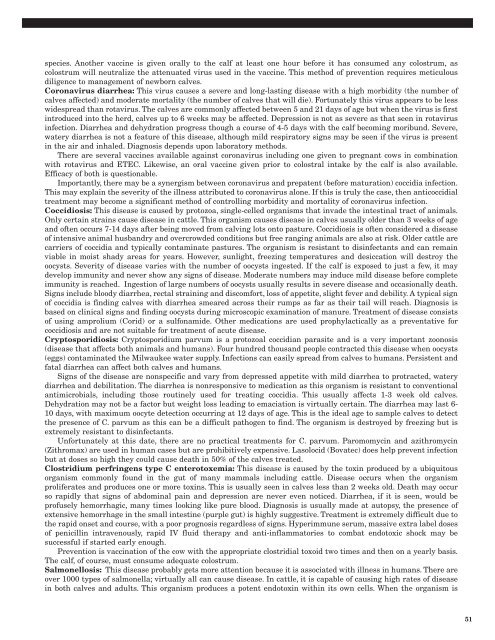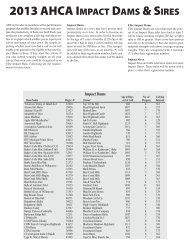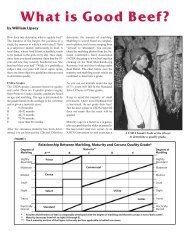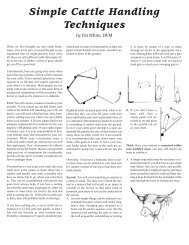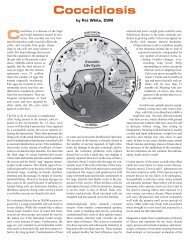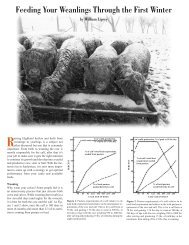The Bagpipe - American Highland Cattle Association
The Bagpipe - American Highland Cattle Association
The Bagpipe - American Highland Cattle Association
Create successful ePaper yourself
Turn your PDF publications into a flip-book with our unique Google optimized e-Paper software.
species. Another vaccine is given orally to the calf at least one hour before it has consumed any colostrum, as<br />
colostrum will neutralize the attenuated virus used in the vaccine. This method of prevention requires meticulous<br />
diligence to management of newborn calves.<br />
Coronavirus diarrhea: This virus causes a severe and long-lasting disease with a high morbidity (the number of<br />
calves affected) and moderate mortality (the number of calves that will die). Fortunately this virus appears to be less<br />
widespread than rotavirus. <strong>The</strong> calves are commonly affected between 5 and 21 days of age but when the virus is first<br />
introduced into the herd, calves up to 6 weeks may be affected. Depression is not as severe as that seen in rotavirus<br />
infection. Diarrhea and dehydration progress though a course of 4-5 days with the calf becoming moribund. Severe,<br />
watery diarrhea is not a feature of this disease, although mild respiratory signs may be seen if the virus is present<br />
in the air and inhaled. Diagnosis depends upon laboratory methods.<br />
<strong>The</strong>re are several vaccines available against coronavirus including one given to pregnant cows in combination<br />
with rotavirus and ETEC. Likewise, an oral vaccine given prior to colostral intake by the calf is also available.<br />
Efficacy of both is questionable.<br />
Importantly, there may be a synergism between coronavirus and prepatent (before maturation) coccidia infection.<br />
This may explain the severity of the illness attributed to coronavirus alone. If this is truly the case, then anticoccidial<br />
treatment may become a significant method of controlling morbidity and mortality of coronavirus infection.<br />
Coccidiosis: This disease is caused by protozoa, single-celled organisms that invade the intestinal tract of animals.<br />
Only certain strains cause disease in cattle. This organism causes disease in calves usually older than 3 weeks of age<br />
and often occurs 7-14 days after being moved from calving lots onto pasture. Coccidiosis is often considered a disease<br />
of intensive animal husbandry and overcrowded conditions but free ranging animals are also at risk. Older cattle are<br />
carriers of coccidia and typically contaminate pastures. <strong>The</strong> organism is resistant to disinfectants and can remain<br />
viable in moist shady areas for years. However, sunlight, freezing temperatures and desiccation will destroy the<br />
oocysts. Severity of disease varies with the number of oocysts ingested. If the calf is exposed to just a few, it may<br />
develop immunity and never show any signs of disease. Moderate numbers may induce mild disease before complete<br />
immunity is reached. Ingestion of large numbers of oocysts usually results in severe disease and occasionally death.<br />
Signs include bloody diarrhea, rectal straining and discomfort, loss of appetite, slight fever and debility. A typical sign<br />
of coccidia is finding calves with diarrhea smeared across their rumps as far as their tail will reach. Diagnosis is<br />
based on clinical signs and finding oocysts during microscopic examination of manure. Treatment of disease consists<br />
of using amprolium (Corid) or a sulfonamide. Other medications are used prophylactically as a preventative for<br />
coccidiosis and are not suitable for treatment of acute disease.<br />
Cryptosporidiosis: Cryptosporidium parvum is a protozoal coccidian parasite and is a very important zoonosis<br />
(disease that affects both animals and humans). Four hundred thousand people contracted this disease when oocysts<br />
(eggs) contaminated the Milwaukee water supply. Infections can easily spread from calves to humans. Persistent and<br />
fatal diarrhea can affect both calves and humans.<br />
Signs of the disease are nonspecific and vary from depressed appetite with mild diarrhea to protracted, watery<br />
diarrhea and debilitation. <strong>The</strong> diarrhea is nonresponsive to medication as this organism is resistant to conventional<br />
antimicrobials, including those routinely used for treating coccidia. This usually affects 1-3 week old calves.<br />
Dehydration may not be a factor but weight loss leading to emaciation is virtually certain. <strong>The</strong> diarrhea may last 6-<br />
10 days, with maximum oocyte detection occurring at 12 days of age. This is the ideal age to sample calves to detect<br />
the presence of C. parvum as this can be a difficult pathogen to find. <strong>The</strong> organism is destroyed by freezing but is<br />
extremely resistant to disinfectants.<br />
Unfortunately at this date, there are no practical treatments for C. parvum. Paromomycin and azithromycin<br />
(Zithromax) are used in human cases but are prohibitively expensive. Lasolocid (Bovatec) does help prevent infection<br />
but at doses so high they could cause death in 50% of the calves treated.<br />
Clostridium perfringens type C enterotoxemia: This disease is caused by the toxin produced by a ubiquitous<br />
organism commonly found in the gut of many mammals including cattle. Disease occurs when the organism<br />
proliferates and produces one or more toxins. This is usually seen in calves less than 2 weeks old. Death may occur<br />
so rapidly that signs of abdominal pain and depression are never even noticed. Diarrhea, if it is seen, would be<br />
profusely hemorrhagic, many times looking like pure blood. Diagnosis is usually made at autopsy, the presence of<br />
extensive hemorrhage in the small intestine (purple gut) is highly suggestive. Treatment is extremely difficult due to<br />
the rapid onset and course, with a poor prognosis regardless of signs. Hyperimmune serum, massive extra label doses<br />
of penicillin intravenously, rapid IV fluid therapy and anti-inflammatories to combat endotoxic shock may be<br />
successful if started early enough.<br />
Prevention is vaccination of the cow with the appropriate clostridial toxoid two times and then on a yearly basis.<br />
<strong>The</strong> calf, of course, must consume adequate colostrum.<br />
Salmonellosis: This disease probably gets more attention because it is associated with illness in humans. <strong>The</strong>re are<br />
over 1000 types of salmonella; virtually all can cause disease. In cattle, it is capable of causing high rates of disease<br />
in both calves and adults. This organism produces a potent endotoxin within its own cells. When the organism is<br />
51


